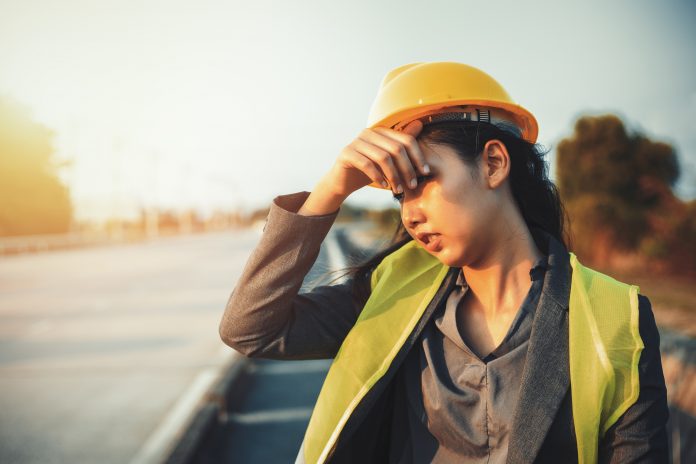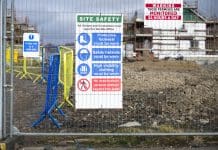Construction workers are at a far greater risk from the associated dangers of too much sun exposure and it is vital that control measures are revised to ensure site workers are kept safe in hot weather. Sophie McCormick, a solicitor at Gateley Legal, explains how
It’s a beautiful summer’s day. I’m sitting behind my laptop, which kindly informs me that it’s 30°C. The blue skies and bright sunshine confirm this, and I’m sure I’m not alone in wishing that I was outside. Many desk-based workers lament their confinement within four walls – particularly in the height of summer. Indeed, it’s not uncommon to feel a pang of jealousy when you walk past a building site to see its workers outside, enjoying the hot weather.
Being active and outdoors are major perks for the construction industry, but they come with their downsides. As temperatures increase, so too do the risks associated with heat and sunlight. Given the nature of their work, construction site workers are more likely to be over-exposed to high temperatures and skin-damaging UV rays than their office-based counterparts. What’s more, with no law stipulating a maximum temperature for working conditions, the responsibility falls largely at the doors of employers and employees to understand the risks and take action to remove, reduce or mitigate them.
Under the Health & Safety at Work etc Act 1974, employers are legally obliged to ensure the health, safety, and welfare of employees, contractors, agency workers and visitors on site, so far as is reasonably practicable. This is particularly important in construction, which accounted for a quarter of the 123 work-related fatalities recorded in 2021 – 2022. It also has a fatal injury rate that is four times as high as the average across all industries, according to the latest statistics from the Health & Safety Executive (HSE).
For employers who do not implement and encourage adequate safe working practices amongst their workforce, the penalties can be severe. From HSE investigations, which can lead to Prohibition Notices and stop work on site, to prosecution, criminal fines, and even imprisonment for individuals with positions of responsibility; the sanctions available to regulators are broad and potentially very damaging.
Responsibility doesn’t just fall on an employer’s shoulders, however. Employees also have a legal obligation to take reasonable care of their health and safety, as well as that of others around them. Nevertheless, an employer can reduce risks by embedding safe working practices across the company’s culture, via training, regular communication, and toolbox talks. The first step is to raise awareness of the risks.
What are the dangers of over-exposure to UV rays?
These days, more people are aware of the dangers of over-exposure to the sun and UV rays, although some people will still take the risk in the name of sun-kissed skin. Yet without sufficient SPF protection, sunlight can cause hyper-pigmentation, burns, premature ageing, and even skin cancer. Eyesight can also be negatively affected by UV rays. Construction site workers are particularly at risk; in large part because they are exposed to the sun for longer amounts of time, with little shade or cover in some cases.
Of course, it is not just UV rays that are dangerous. Strenuous activity in hot weather leads to dehydration, sweating, discomfort, and dizziness, and in more serious cases, heat stroke. It is also important to remember that overheating impacts concentration, reaction times and judgement, thus increasing the risks of certain activities, particularly if they involve working at height or handling equipment, plant, or machinery.
Examine the relevant risks and implement measures to mitigate them
It would not be feasible or financially viable to shut construction sites over summer. British weather is too unpredictable, for one. Furthermore, whilst it is advisable to schedule work outside the hours when the sun is at its strongest (usually between 1pm and 3pm), realistically it is not often possible to do so. The key, then, is to examine the relevant risks and implement measures that could reduce or mitigate them.
For starters, make good quality sunscreen of at least SPF 15 readily available on site so that employees can apply it regularly. Every two hours is best, as sweating and rubbing from clothing will remove sunscreen more quickly. Ideally, you should also encourage employees to apply it two hours before going outside, as once skin starts to burn, the damage is already done.
In addition to sunscreen, cool drinking water should also be readily available, whether that is via access points or stocks of bottled water. Construction site workers are physically active and will lose a lot of moisture due to sweat – too much and they could become dehydrated, which leads to headaches, dizziness, tiredness, and even changes in heart rate and blood pressure.
Both items above can be facilitated by encouraging regular breaks, but another key consideration is Personal Protective Equipment (PPE). The last things people want to wear when it’s hot are heavy coats, long sleeves, and hard hats, and it could be tempting to remove shirts and loosen harnesses in the name of comfort. As well as exposing skin to sunlight, however, this completely undermines the protection that such equipment provides.
It may be possible to adapt certain clothing to suit the hot weather, by using more lightweight material for example. If not, communicate expectations but make it clear that extra breaks will be provided to allow people time to cool down and rest.
Bear in mind that there may be people within your workforce with underlying medical conditions or attributes which makes them more susceptible to sun damage. It might be that you need to do more to support and protect those site workers.
Provide evidence of how you have assessed risks
As previously mentioned, site workers have a responsibility to pay due regard to their own safety, but the HSE will also want evidence of how you have assessed risks, implemented control measures, and communicated them across site. Remember, you could be held personally liable for accidents that take place on site.
Consider, therefore, adding heat and sun protection to your training and induction programmes, and schedule in refreshers as the weather gets hotter. For protective measures such as sunscreen and water, prompt employees through posters or signs, and make sure both water and sun protection are readily available in your designated break-out areas or welfare facilities.
Encourage your team to be accountable to themselves and each other too. For example, can they spot the symptoms of heat stroke or dehydration in their colleagues? Do they know what the consequences might be for non-compliance, from both a health and a work perspective? The more you communicate, act on, and follow up these measures, the more likely they are to become a natural part of your site’s working practices.
As a final note, make sure that any first aiders you have on site are trained to recognise the symptoms of severe heat stress and dehydration, and know what to do if this occurs. For severe cases you will need to call the emergency services, but first aiders will also need to know how to cool someone down and get them to a position of safety before an ambulance arrives.
All these measures are not about removing responsibility from the individual. Instead, they give you the tools and information you need to justify the importance of safe working practices in hot weather, to communicate this to your site workers and ensure everyone complies. After all, one of the key roles of a construction or site manager is to ensure work is completed to a high standard and to schedule, both of which are far less likely if accidents and near misses occur more frequently than they should. More importantly, safe sites also ensure that employees can do their job and get home safely, whatever the weather.














